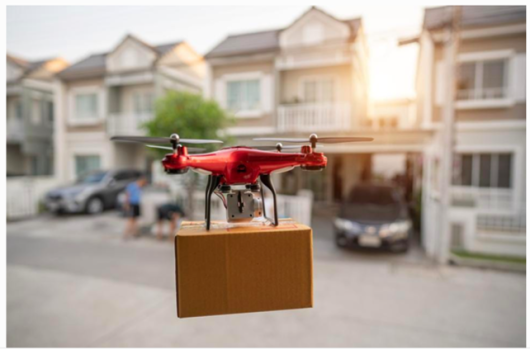K
Kathleen Martin
Guest
In the first blog in the AI transportation and logistics (T&L) series, I featured AI transformation innovations at Purolator; the second blog focused on the acceleration of smarter AI telematics in fleet management. The third blog explored AI emotion sensors and the impact that the affective computing market is having on the transportation and logistics industry. The fourth blog discussed AI revenue growth and operational optimization use cases to ensure that your T&L company is positioned for accelerated growth. This fifth blog and is looking at the impact of robotic drones.
AI : Robotic Drones - Why is this important?
First the drone logistics and transportation market is estimated by Precedence Research to surpass US$ 41.4B by 2030 and is growing at a CAGR of 21.2% from 2021 to 2030. According to Precedence Research, the drone logistics and transportation market size was valued at US$ 8.7 billion in 2020. Drones are defined as unmanned aerial vehicles that can be operated from a remote area. These unmanned aerial vehicles are used for various purposes such as in delivery services, border surveillance, combat operations and many others. The delivery services provided by the commercial drones are more cost effective and time efficient in nature. It has an accurate locating program that enables the accurate location of the consumer and this helps in delivering the packages faster. With the advancement of technologies, innovative features can be added to the drones that improves their efficiency. All these attributes of the drones is expected to drive the growth of the drone logistics and transportation market.
Unmanned aerial vehicles are expected to generate $82 billion in economic growth by 2025 along with 100,000 jobs. Despite recent regulations, the USA Federal Aviation Administration (FAA) has issued hundreds of waivers to companies interested in commercial drone use. While drones will impact a number of industries, they will have the greatest impact on supply chain and logistics. Some of the rulings require special notice and awareness on some of the go to market complexities in building drones.
For companies interested in commercial drone usage like drone delivery, several rules stand in their way. Most notably, the “line of sight” rule which requires drone owners to keep their drones within eye shot at all times. For other limitations, businesses can apply for waivers to circumvent the regulations, including:
· Flying a drone from a moving aircraft or a vehicle in a populated area,
· Flying at night,
· Flying multiple drones with only one remote pilot,
· Flying over people,
· Flying over 400 feet above ground level,
· Flying over 100 miles per hour groundspeed, and
· Flying with less than 3 statute miles of visibility.
Continue reading: https://www.forbes.com/sites/cindygordon/2021/10/31/advancing-ai-revenue-growth-insights-in-the-transportation-and-logistics-industry-series-blog-5/?sh=747073091049
AI : Robotic Drones - Why is this important?
First the drone logistics and transportation market is estimated by Precedence Research to surpass US$ 41.4B by 2030 and is growing at a CAGR of 21.2% from 2021 to 2030. According to Precedence Research, the drone logistics and transportation market size was valued at US$ 8.7 billion in 2020. Drones are defined as unmanned aerial vehicles that can be operated from a remote area. These unmanned aerial vehicles are used for various purposes such as in delivery services, border surveillance, combat operations and many others. The delivery services provided by the commercial drones are more cost effective and time efficient in nature. It has an accurate locating program that enables the accurate location of the consumer and this helps in delivering the packages faster. With the advancement of technologies, innovative features can be added to the drones that improves their efficiency. All these attributes of the drones is expected to drive the growth of the drone logistics and transportation market.
Unmanned aerial vehicles are expected to generate $82 billion in economic growth by 2025 along with 100,000 jobs. Despite recent regulations, the USA Federal Aviation Administration (FAA) has issued hundreds of waivers to companies interested in commercial drone use. While drones will impact a number of industries, they will have the greatest impact on supply chain and logistics. Some of the rulings require special notice and awareness on some of the go to market complexities in building drones.
For companies interested in commercial drone usage like drone delivery, several rules stand in their way. Most notably, the “line of sight” rule which requires drone owners to keep their drones within eye shot at all times. For other limitations, businesses can apply for waivers to circumvent the regulations, including:
· Flying a drone from a moving aircraft or a vehicle in a populated area,
· Flying at night,
· Flying multiple drones with only one remote pilot,
· Flying over people,
· Flying over 400 feet above ground level,
· Flying over 100 miles per hour groundspeed, and
· Flying with less than 3 statute miles of visibility.
Continue reading: https://www.forbes.com/sites/cindygordon/2021/10/31/advancing-ai-revenue-growth-insights-in-the-transportation-and-logistics-industry-series-blog-5/?sh=747073091049

